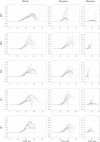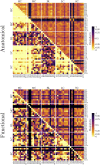Adaptive rewiring in nonuniform coupled oscillators
- PMID: 35356195
- PMCID: PMC8959120
- DOI: 10.1162/netn_a_00211
Adaptive rewiring in nonuniform coupled oscillators
Abstract
Structural plasticity of the brain can be represented in a highly simplified form as adaptive rewiring, the relay of connections according to the spontaneous dynamic synchronization in network activity. Adaptive rewiring, over time, leads from initial random networks to brain-like complex networks, that is, networks with modular small-world structures and a rich-club effect. Adaptive rewiring has only been studied, however, in networks of identical oscillators with uniform or random coupling strengths. To implement information-processing functions (e.g., stimulus selection or memory storage), it is necessary to consider symmetry-breaking perturbations of oscillator amplitudes and coupling strengths. We studied whether nonuniformities in amplitude or connection strength could operate in tandem with adaptive rewiring. Throughout network evolution, either amplitude or connection strength of a subset of oscillators was kept different from the rest. In these extreme conditions, subsets might become isolated from the rest of the network or otherwise interfere with the development of network complexity. However, whereas these subsets form distinctive structural and functional communities, they generally maintain connectivity with the rest of the network and allow the development of network complexity. Pathological development was observed only in a small proportion of the models. These results suggest that adaptive rewiring can robustly operate alongside information processing in biological and artificial neural networks.
Keywords: Complexity; Dynamical systems; Evolving neural networks; Neural oscillators.
© 2021 Massachusetts Institute of Technology.
Figures












References
-
- Berlingerio, M., Koutra, D., Eliassi-Rad, T., & Faloutsos, C. (2012). NetSimile: A scalable approach to size-independent network similarity. arXiv:1209.2684.
LinkOut - more resources
Full Text Sources
